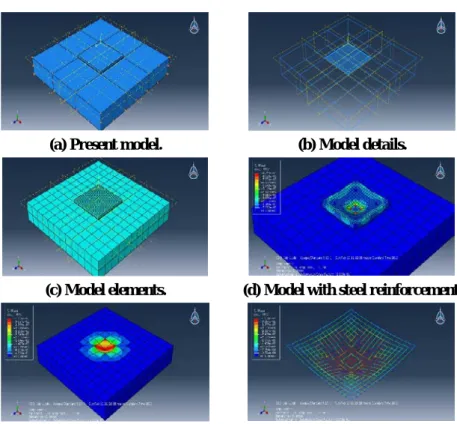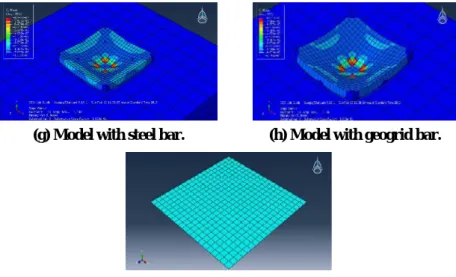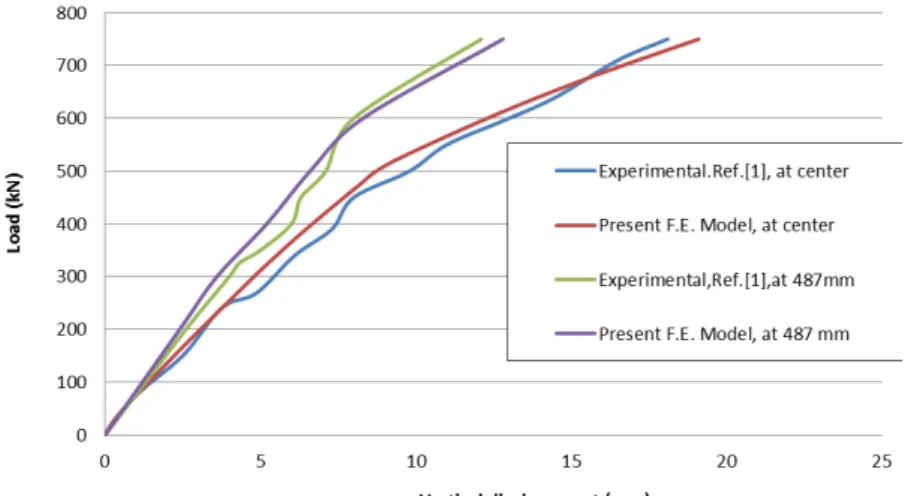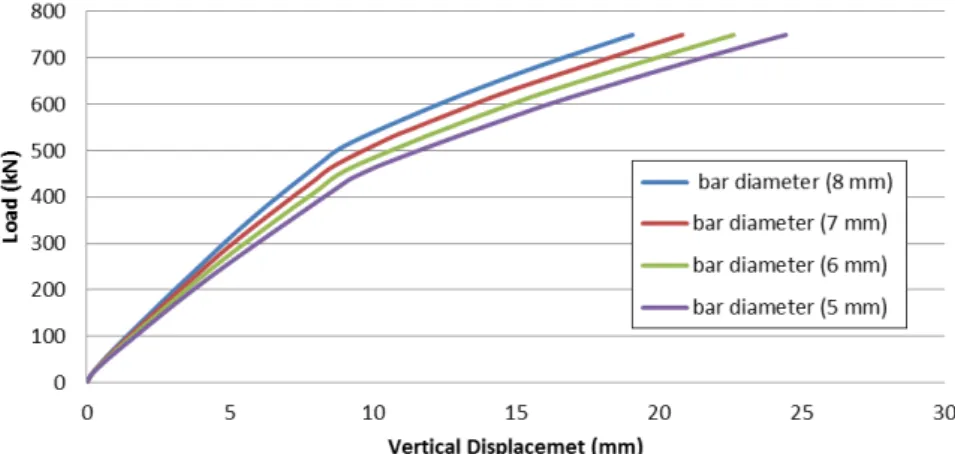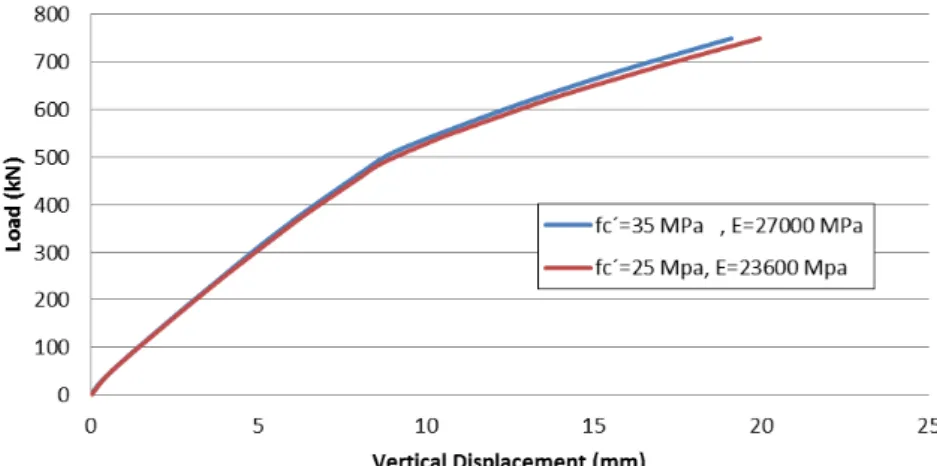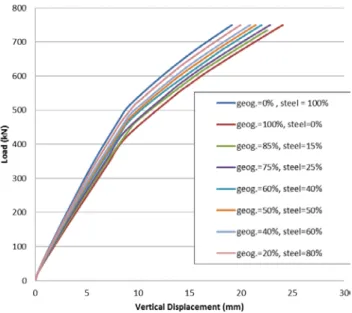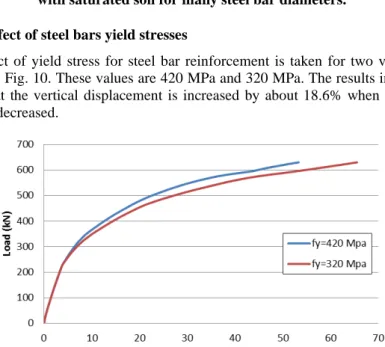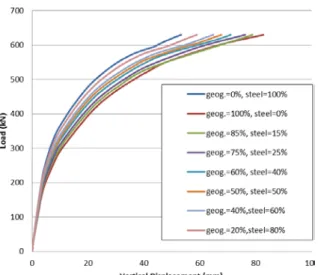© School of Engineering, Taylor’s University
NUMERICAL SIMULATION OF BEHAVIOUR
OF REINFORCED CONCRETE BARS IN SATURATED
SOIL USING THEORETICAL MODELS
ALI SABAH AL AMLI1,2,*, NADHIR AL-ANSARI2, JAN LAUE2 1Department of Civil Engineering, Al-Mustansiriyah University,
Palestine Street, Baghdad 10052, Iraq
2Department of Civil, Environmental and Natural Resources Engineering, Lulea University of Technology, Lulea 971 87, Lulea, Sweden
*Corresponding Author: ali.sabah@ltu.se
Abstract
This study presents a nonlinear analysis for square reinforced concrete (RC) foundation slab with bars used with both unsaturated and saturated soils in order to investigate,which response is affected by loading. Different parametric studies are undertaken in this study to determine the effect of load-displacement relationships for RC member or foundation with different cases such as (the distance of bars, diameters of bars reinforcement, types of reinforcement bars steel bars and geogrid reinforcement, yield stress for reinforcement and modulus of elasticity with compressive strength for concrete). A finite element model by ABAQUS software program is used to predict the load versus vertical displacement response of the tested RC foundations with soil by using other researchers´ experimental results. The present finite element models account for the constituent load-displacement behaviour between the RC foundations with soil and the effective load. The numerical results were compared with the experimental results obtained from other research, and good correlations were obtained. The models developed in this study can accurately capture the behaviour and predict the load-displacement of RC foundation with soil. This study shows that geogrid reinforcement enhanced the capacity of the foundation or member when used with different ratios of steel bars in soil and this provides a sustainable solution by reducing steel reinforcement. This geogrid ratio between 20% to 40% from the reinforcement, while the member in saturated soil is less strong than it when in unsaturated soil.
1. Introduction
Soil-structure interaction such as the interaction between subsoil and foundation is a very important field of research in civil engineering. A reinforced concrete (RC) foundation structure is the most important part of the whole structure and its quality has an important effect on the overall quality of buildings. Foundations can influence the durability of a building, and incorrectly designed and installed foundations can cause considerable problems.
For example, excessive deformation or settlement of the RC foundation’s construction may cause problems with the upper construction (superstructure above the foundation) and may increase maintenance costs. The ideal solution to this problem is not oversizing or repairing but the rather right design and right execution. For the right design, it is necessary to know the behaviour of the RC foundations on the subsoil [1-4].
Girgin et al. [5] mentioned that the best RC members are designed to develop displacements in their end regions. Thus, the occurrence of longitudinal bar regions can crucially affect the ductility of such part of structures. The performance assessment for RC structures should rely on analytical models, which can account for the effects of reinforcement bar responses. Hence, this research extends a previously proposed study for modelling RC bar that is affected by the RC foundation soil.
Based on studies by Al Amli et al. [6], a geogrid is used for providing strength with the suitable cost for the reinforcement in RC foundations. A geogrid is used with soil- structure members to treat corrosion, and its shape gives it more bonds with the concrete. Therefore, there is an advantage of used geogrid in the structure that has contact with soil or saturated soil, which may contain many types of liquids because it acts as a reinforcement bar for the foundation.
Geosynthetics are widely used for protection, separation, drainage, filtration and sealing [7]. Also, for the construction of steep slopes, the high strength geogrids used with more successfully. Particularly in the latter case, geosynthetics with additional features have been developed allowing permanent monitoring of the deformations.
From that, geogrid reinforcement structures show many advantages in terms of economic aspects when compared to classic concrete members. It is also well known from large-scale experiments and field tests that geosynthetic-reinforced constructions have much higher bearing capacity than that calculated, and the deformations are much lower than expected. However, it is quite evident that the combined behaviour of geosynthetics and soils is not yet completely understood [7].
In civil engineering projects, Geosynthetics have been increasingly used. This used as reinforcing construction material [8-12]. The developed Finite Element (FE) models account of RC member can accurately capture the behaviour of load-capacity of members [13-17]. In this research, two types of reinforcement are used, such as steel bar reinforcement and geogrid reinforcement with RC foundations in both saturated and unsaturated soils. The FE software ABAQUS was used to develop a three-dimensional, nonlinear finite element model capable of simulating the effect of reinforcing bars in concrete foundations with different types of soils.
According to Buchta et al. [1], the interaction properties used in the present model provided accurate results in comparison with the experimental results, thus, the model
has successfully simulated RC foundations with different soils. The results of the existing finite element model are used to study load-displacementt relationships with the effect of the bars diameter size, steel bars and geogrid reinforcement, the yield stresses of steel bars and the properties of concrete.
These cases were taken with the effects of saturated and unsaturated soil. This research is very important for decreasing the corrosion in reinforcement and decreasing the cost by decrease the steel bar reinforcement. Thus, by knowing the behaviour of RC bars in foundation with soil effects. Consequently, two types of bars are taken in this study: geogrid and steel bars reinforcement. In addition, many researchers have studied the repair of reinforced concrete structures [18-20], and these researches may be developed in future to augment the study of repair needs and implementation.
The purpose of this study is to obtain the behaviour of a reinforced concrete member (foundation) with the soils and to find another type of reinforcement to reduce steel reinforcement bars, which are affected by corrosion. Also, to find the desired reinforcement, but at a lower cost such as the geogrid. This study shows that geogrid reinforcement gives the good capacity to the foundation when used with different ratios of steel bars in soils (saturated and unsaturated) and this provides a sustainable solution by reducing steel reinforcement bars.
2. Finite element modelling
This research considers RC foundations when used with soils (saturated and unsaturated). Geogrid and Steel bars are used as reinforcement. An RC foundation with soil is modelled as follows.
2.1. Element types
The R.C. foundations with soils and reinforcement by geogrid and steel bars are represented by the following elements.
2.1.1. Foundation and soil
8-node linear brick reduced integration element.This element is used to represent the member and soil with all directions, and it allowed to the load and displacement to be at the required direction.
2.1.2. Steel reinforcement
2-node linear, 3-D truss element.This element is used to represent the steel bar with any member as embedded inside the member.
2.1.3. Geogrid
4-node quadrilateral, surface element.This element is used to represent the geogrid as a reinforce surface, and this surface can use with any member as embedded inside the member.
2.2. Plasticity models
2.2.1. Foundations
Concrete damage plasticity.This way in the plastic model to get the deformation in the member or foundation without penetration it.
2.2.2. Soil
Mohr-coulomb plasticity.
2.2.3. Steel reinforcement and geogrid Classic metal plasticity.
2.3. Reinforcement simulation
The simulation for the geogrid and steel bar reinforcement is as follows:
• The steel bars were simulated as a multiple-trusses.The interaction between steel bars and concrete was simulated that steel bars embedded inside the concrete member.
• Geogrid was simulated as a surface embedded inside the concrete (the surface was modelled with a rebar option, which can simulate the actual geogrid properties). Figure 1 shows the modelling for an RC foundation with two types of reinforcement (steel and geogrid reinforcement) with saturated and unsaturated soils.
(a) Present model. (b) Model details.
(c) Model elements. (d) Model with steel reinforcement.
(g) Model with steel bar. (h) Model with geogrid bar.
(i) Model of geogrid.
Fig. 1. Modelling for reinforced concrete foundation with many types of reinforcement bars and soil.
3. Material
The RC foundation has dimensions 2 m × 2 m, with 0.15 m thickness and with a 0.4 m × 0.4 m area for the applied load. The numerical simulations for the behaviour of the RC bars (steel of a geogrid reinforcement) with saturated soil and unsaturated soil using finite element models by ABAQUS.The properties of all the materials are based on the results of field tests done in this study. The properties for concrete, which has a compressive strength fc´ and young’s modulus of elasticity E, are 35 MPa and 27000 MPa, respectively. The properties of the soil, steel and geogrid reinforcement are as the following.
3.1. Soil constitution
The well-known Mohr-coulomb model has been considered as a first-order approximation of real soil behaviour. This elastic-plastic model requires the parameters shown in Table 1.
Table 1. Soil parameters.
Soil parameter Unsaturated Saturated
Young’s modulus (E) 50 MPa 40 MPa Poisson ratio (v) 0.3 0.49 Cohesion (c) 90 kPa 50 kPa Friction angle (ɸ) 20° 0 Dilatancy angle (Ψ) 0 0
3.2. Steel model
Steel bars are generally used to model soil reinforcements. The steel bar was modelled using an elastic-plastic model with the following parameters: Young’s modulus (E), 200000 MPa, Poisson ratio (v), 0.3, and yield stress (Fy), 420 MPa.
3.3. Geogrid model
Geogrids are elastic flexible elements with a normal stiffness and no bending stiffness. These objects are generally used to model soil reinforcements. The geogrid was modelled using an elastic-plastic constitutive model with the following parameters: Young’s modulus (E), 67000 MPa, Poisson ratio (v), 0.2, and yield stress (Fy), 100 kN/m.
4. Results and Discussion
RC foundations with saturated soil are studied to know the load-displacement relation. The vertical displacement with a vertically applied load gives the behaviour of RC foundation, and different parametric studies are taken in this study.
The results for RC foundations with two types of soil (unsaturated and saturated) over many parametric studies are shown below. Figure 2 shows the relationship between the load and displacement with unsaturated soil. The load-displacement relations for RC foundations are studied here with many variations and with two types of soil: unsaturated and saturated soil. Two nodes are taken in this study, the first at the centre of the members, and the second at 487 mm from the centre. The results in Fig. 2 show a good agreement and similarity between the present finite element theoretical model for this study and the experimental results [1]. The difference between the experimental results and the present results for the displacement is about 5%. Thus, the present model in this study can give good results to study the behaviour of RC foundations in unsaturated soil and saturated soil with different parameters.
Fig. 2. Load-displacement relationships in RC foundations with unsaturated soil experimentally and the present FE model. [1]
4.1. Reinforced concrete foundation with unsaturated soil
4.1.1. Effect of steel bar diameters
The steel bar diameter effects for load-displacement results for RC foundations with unsaturated soil are shown in Fig. 3. The bar diameters are used for the small member, which is used as experimental or theoretical model to represent the required reinforcement by the small bar diameters [1]. The bar diameters used in
this study are (5, 6, 7, and 8 mm). The results show that an increase in bar diameter gives more strength, and thus, when the bar diameter is decreased, the deflection or vertical displacement is increased. When the bar diameter is decreased from 8 mm to 7 mm, 6 mm and 5 mm, the vertical displacement increases by 8.3%, 17% and 22%, respectively.
Fig. 3. Load-displacement relationships in RC foundations with unsaturated soil for many steel bar diameters. 4.1.2. Effect of steel bars yield stresses
The effect of yield stress for steel bar reinforcement is taken for tow values as shown in Fig. 4. These values are 420 MPa and 320 MPa. The results show that the vertical displacement is increased when the yield stress is decreased. This increase in vertical displacement is about 7.4%.
Fig. 4. Load-displacement relationships in RC foundation model in unsaturated soil with yield stress for steel bar reinforcement. 4.1.3. Effect of concrete properties
The properties of concrete are given in Fig. 5 with different values of compressive strength (35 and 25 MPa) and with different values for young’s modulus (27000 and 23000 MPa), respectively. The results in Fig. 5 show that, when the compressive strength of the concrete and the modulus of elasticity are decreased
from (35 MPa and 27000 MPa) to (25 MPa and 23600 MPa), respectively, the vertical displacement is increased by 4.2%.
Fig. 5. Load-displacement relationships in RC foundation model in unsaturated soil with different properties of concrete. 4.1.4. Effect of effective depth (d)
The effect of the distance from the bar to the top of the foundations (Effective depth) is taken for RC foundation with unsaturated soil. Figure 6 shows three values of d (120 mm, 125 mm and 130 mm). The results in Fig. 6 show the same behaviour but with different values of vertical displacement. The results show that, when the distance (d) is decreased from 130 mm to 125 mm and 120 mm, the vertical displacement increases by 3.8% and 7.9%, respectively.
Fig. 6. Load-displacement relationships in RC foundation model in unsaturated soil with many distances of steel bar reinforcement (d). 4.1.5. Effect of steel and geogrid reinforcement ratios
The effects of the type of reinforcement bars are very important. Therefore, in this study, two types of reinforcement bar are considered for RC foundations with soil. The first is a steel bar reinforcement and the second is geogrid reinforcement. Figure 7 shows the load-displacement relationship for an RC foundation with unsaturated soil. The results
in Fig. 7 show that, when the geogrid ratio becomes 100%, the vertical displacement increases by about 20.576% more than without a geogrid (steel reinforcement only). When the geogrid ratios become less than 100%, that is when the geogrid ratios become 85%, 75%, 60%, 50%, 40% and 20%, the vertical displacement increases by about 18.315%, 16.28%, 13.135%, 10.822%, 8.47% and 4.207%, respectively, compared to the steel reinforcement only.
Fig. 7. Load-displacement relationships in RC foundation model in unsaturated soil with different ratios of steel bars and geogrid reinforcement.
4.2. Reinforced concrete foundation with saturated soil
Figure 8 shows the load-displacement relationship for RC foundations with two types of soil, (unsaturated and saturated). The results in Fig. 8 show that the behaviour of the load-displacement relationship in saturated soil gives a larger vertical displacement of about 64% and a smaller carrying load of about 16%. This behaviour appears to be the effect of the saturated soil making the RC foundations weaker and so having less capacity to carry the loads.
Fig. 8. Load-displacement relationships in RC foundations models in different soils (unsaturated and saturated).
4.2.1. Effect of steel bar diameters
Figure 9 shows the variations in the steel bar diameter for the RC foundation with saturated soil. The bar diameters for this study are (5, 6, 7 and 8 mm). The results in Fig. 9 show the steel bar diameter effects for load-displacement for RC foundations with unsaturated soil. The bar diameters, here are (8, 7, 6 and 5 mm). The results show that an increase in bar diameter gives more strength, and thus, when the bar diameter is decreased, the deflection or vertical displacement is increased. When the bar diameter is decreased from 8 mm to 7 mm, 6 mm and 5 mm, the vertical displacement increases by about 19%, 31.5% and 40% respectively.
Fig. 9. Load-displacement relationships in RC foundations with saturated soil for many steel bar diameters. 4.2.2. Effect of steel bars yield stresses
The effect of yield stress for steel bar reinforcement is taken for two values, as shown in Fig. 10. These values are 420 MPa and 320 MPa. The results in Fig. 10 show that the vertical displacement is increased by about 18.6% when the yield stress is decreased.
Fig. 10. Load-displacement relationships in RC foundation model in saturated soil with yield stress for steel bar reinforcement.
4.2.3. Effect of concrete properties
The properties of concrete are considered in Fig. 11 for compressive strength and young’s modulus, with different values of compressive strength (35 and 25 MPa) and different values for young’s modulus (27000 and 23000 MPa), respectively. The results in Fig. 11 show that, when the compressive strength of concrete and modulus of elasticity are decreased from (35 MPa and 27000 MPa) to (25 MPa and 23600 MPa), respectively, the vertical displacement is increased by about 10.4%.
Fig. 11. Load-displacement relationships in RC foundation model in saturated soil with different properties of concrete. 4.2.4. Effect of effective depth (d)
The effect of distance from the bar to the top of the foundation (effective depth) is considered for RC foundations with unsaturated soil. Figure 12 shows three values for d (130 mm, 125 mm and 120 mm).
Fig. 12. Load-displacement relationships in RC foundation model in saturated soil with many distances of steel bar reinforcement.
The results show the same behaviour but with different values of vertical displacement. The results show that when the distance (d) is decreased the vertical displacement is increased. When (d) is decreased from 130 mm to 125 mm, the vertical displacement increases by about 10.5% similarly, when the distance (d) becomes 120 mm, the foundations become weaker. This behaviour is shown when the carrying load becomes 564.33 kN. Thus, when the soil becomes saturated; the decrease in the distance from the bar to the top of the foundations (d) reduces the strength of the foundations.
4.2.5. Effect of steel and geogrid reinforcement ratios
The effect of the type of reinforcement bar is very important. Therefore, in this study, two types of reinforcement bar are considered for RC foundations with soil. The steel bar reinforcement and the geogrid reinforcement with different ratios are shown in Fig. 13, along with the load-displacement relations for RC foundations with unsaturated soil. The results show that, when the geogrid ratio becomes 100%, the vertical displacement increases by about 35.6% more than without a geogrid (steel reinforcement only). When the geogrid ratios become less than 100% , that is when the geogrid ratios become 85%, 75%, 60%, 50%, 40% and 20%, the vertical displacement increases by about 32.2%, 30%, 25%, 21.2%, 17.7% and 9.5%, respectively, compared to steel reinforcement only.
Fig. 13. Load-displacement relationships in RC foundation model in saturated soil with different ratios of steel bars and geogrid reinforcement.
5. Conclusions
To improve the performance of RC foundations with different bars in the present work, this study involved this method of analysis:
• The present model can simulate and represent the RC foundations with saturated soil and unsaturated soil with many types of reinforcement bars. • The behaviour of RC member or foundation in saturated soil is different for its
behaviour in the unsaturated soil. Since the strength of the member in saturated soil is less than its strength when used with unsaturated soil.
• The effect of the distance (d), which represents the effective depth for the reinforcement, is important in saturated soil that makes the RC foundation with less strength. When (d) increased the strength, capacity is increased.
• The geogrid ratios, which give the required strength to the RC member or foundation are 20% to 40% with steel reinforcement ratios 80% to 60%, respectively.
• Geogrid reinforcement ratios when to be more than 40% need to check the strength of the RC member by analysis to get the best design.
Nomenclatures
c Cohesion, KPa d Effective depth, m
E Young’s modulus of elasticity, MPa
fc’ Compressive strength of the concrete, MPa fy Yield stress, MPa
Greek Symbols
v Poisson ratio
ɸ Friction angle of the soil, degree Ψ Dilatancy angle of the soil, degree Abbreviations
FE Finite Element Geog. Geogrid
RC Reinforced Concrete
References
1. Buchta, V.; Janulikova, M.; and Fojtik, R. (2015). Experimental tests of reinforced concrete foundation slab. Proceedings of the 1st International Conference on Structural Integrity. Madeira, Portugal, 530-537.
2. Kearsley, E.P.; and Elsaigh, W. (2003). Effect of ductility on load-carrying capacity of steel fiber-reinforced concrete ground slabs. Journal of the South African Institution of Civil Engineers, 45(1), 25-30.
3. Alani, A.M.; Rizzuto, J.; Beckett, D.; and Aboutalebi, M. (2014). Structural behaviour and deformation patterns in loaded plain concrete ground-supported slabs. Structural Concrete, 15(1), 81-93.
4. Tiberti G.; Minelli F.; and Plizzari, G. (2015). Cracking behavior in reinforced concrete members with steel fibers: A comprehensive experimental study. Cement and Concrete Research, 68, 24-34.
5. Girgin, S.C.; Koutromanos, I.; and Moharrami, M. (2016). Numerical simulation of reinforced concrete members with reinforcing bar buckling.
Proceedings of the 12th International Conference on Advances in Civil
Engineering. Istanbul, Turkey, 1-8.
6. Al Amli, A.S.A.; Yousif, M.A.; and Mohammed, M.M. (2017). Reinforced concrete strengthening by using geotextile reinforcement for foundations and slabs. International Journal of Civil, Structural, Environmental and
Infrastructure Engineering, Research and Development (IJCSEIERD), 7(3), 35-46.
7. Ziegler, M. (2017). Applications of geogrid reinforced constructions: history, recent and future developments. Procedia Engineering, 172, 42-51.
8. Sharma, R.; Chen, Q.; Abu-Farsakh, M.; and Yoon, S. (2009). Analytical modeling of geogrid reinforced soil foundation. Geotextiles and Geomembranes, 27(1), 63-72.
9. Kolay, P.K.; Kumar, S.; and Tiwari, D. (2013). Improvement of bearing capacity of shallow foundation on geogrid reinforced silty and sand. Journal of Construction Engineering, Article ID 293809, 10 pages.
10. Vashi, R.; Patel, A.; and Patel, K. (2017). A parametric study on behavior of geogrid reinforced earth retaining wall. Proceedings of the International Conference on Research and Innovations in Science, Engineering and Technology (ICRISET). Anand, India, 514-519
11. Tang, X.-S.; Zheng, Y.-R.; and Wang, Y.-F. (2014). Application and analysis of the reinforcing wall with geogrid. Proceedings of the International Conference on Mechanics and Civil Engineering. Chongqing, China, 499-507.
12. Bolt, A.F.; and Duszynska, A. (2000). Pult-out testing of geogrid reinforcements. Proceedings of the Second European Geosynthetics Conference. Bologna, Italy, 1-7.
13. Hawileh, R.A. (2015). Finite element modeling of reinforced concrete beams with a hybrid combination of steel and aramid reinforcement. Materials and Design, 65, 831-839.
14. Nam, S.-H.; Song, H.-W.; Byun, K.-J.; and Maekawa, K. (2006). Seismic analysis of underground reinforced concrete structures considering elasto-plastic interface element with thickness. Engineering Structures, 28(8), 1122-1131. 15. Delalibera, R.G.; and Giongo, J.S. (2018). Theoretical and numerical analysis
of reinforced concrete beams with confinement reinforcement. Ibracon Structures and Materials Journal, 1(1), 17-30.
16. Ahmed, A.S. (2017). Behavior of repairing composite modified reactive powder concrete I section beams with opening under pure torque. Journal of Engineering and Sustainable Development, 21(1), 39-50.
17. Al Amli, A.S.; Al-Ansari, N.; and Laue, J. (2019). Study numerical simulation of stress-strain behavior of reinforced concrete bar in soil using theoretical models. Civil Engineering Journal, 5(11), 2349-2358.
18. Al Amli, A.S.; Al-Ansari, N.; and Shejiri, S.J.D. (2018). Repairing of RC T-section beams with opening by CFRP for cracks and ultimate torque. Journal of Civil Engineering and Architecture, 12, 83-90.
19. Al Amli, A.S.; Al-Ansari, N.; and Abtan, Y.G. (2018). Behavior of repairing composite I-section beams with opening under ultimate torque. Engineering, 10(4), 202-214.
20. Teng, K.H.; Kot, P.; Muradov, M.; Shaw, A.; Hashim, K.; Gkantou, M. and Al-Shamma’a, A. (2019). Embedded smart antenna for non-destructive testing and evaluation (NDT&E) of moisture content and deterioration in concrete. Sensors, 19(3), 1-12.
